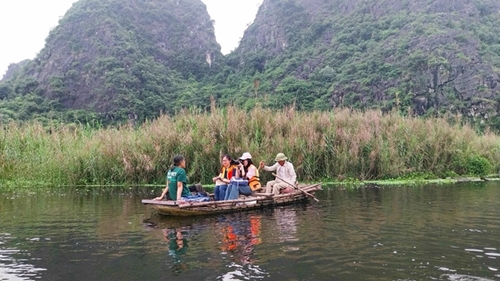Preserving nature, creating more jobs
Covering an area of 2,484.3 hectares across seven communes of Gia Hung, Lien Son, Gia Hoa, Gia Van, Gia Lao, Gia Tan, and Gia Thanh in Gia Vien district, Van Long Wetland Nature Reserve is the largest wetland area in the Northern Delta region.
At Van Long, nature conservation plays a crucial role in maintaining a diverse ecosystem and protecting endangered flora and fauna species. It has 11 ecosystems with 722 higher plant species, 258 algae species, 39 mammal species, 43 fish species, 38 reptile species, and 100 bird species. There are 39 animal species, including 12 rare ones such as the delacour's langur, Asian black bear, Macaca arctoides, and owston's civet chrotogale owstoni.
    |
 |
|
Tourists on Van Long Lagoon |
In 2018, Van Long became the ninth Ramsar site (wetland of international importance) in Vietnam. This area boasts two records in the Vietnam Book of Records, namely “The place with the highest number of delacour’s langur” and “The place with the largest natural picture.”
Leveraging the available potential and advantages, Van Long Eco-tourism Service Cooperative has built and developed a sustainable tourism model, gradually attracting domestic and foreign visitors. In addition to livestock farming and rice cultivation, local farmers have been mobilized to participate in tourism business activities and welcome visitors to explore ecosystems in Van Long. This model not only helps increase livelihoods and create more jobs for people, but also contributes to preserving and spreading the local cultural identity.
Strengthening biodiversity conservation
According to Director of Van Long Eco-tourism Service Cooperative Tran Xuan Quang, the development of tourism in Van Long is aimed at not only exploiting economic values, but also conserving natural resources. Every year, local people directly engaged in tourism service activities are updated with information and skills. They also sign commitment to practice civilized lifestyle and protect the natural landscape and environment.
Tourism products in Van Long include boat tours to explore the natural landscape and observe bird species and wild animals in their natural habitats. These activities are designed to minimize negative impacts on the environment, contributing to protecting Van Long and raising the community's knowledge and awareness of nature conservation.
According to Director of the Management Board of Hoa Lu - Van Long Special-use Forest Mai Van Quyen, the protection of the environmental landscape and biodiversity in Van Long plays an important role in the sustainable development of tourism sector of the province in particular and its economy in general, helping increase income and improve living standards of local people. The unit has collaborated with local functional agencies and sectors to implement support programs to help people learn how to develop forests linked to livelihoods, make rational use of land and water resources, and protect biodiversity. Instead of relocation, the unit turns local people into core force in implementing the goal of sustainable conservation and fosters dissemination to enhance their awareness of environmental protection associated with tourism development.
In addition to that, the successful implementation of afforestation and forest protection has contributed to increasing the forest coverage rate, creating a living environment for various animal and plant species. For example, the delacour's langur, which had only 40 individuals in 2000, has now increased to 250.
Although Van Long has obtained many achievements in combining tourism development and nature conservation, it still faces many challenges due to impacts of climate change and adverse weather factors, requiring careful planning and investment. Quyen said that the increase in the number of tourists can put pressure on the ecosystem, cause environmental pollution, and deteriorate landscape quality.
In the time to come, the management board will complete and disseminate policies on biodiversity conservation to those participating in tourism activities. Therein, emphasis will be placed on communication and education to raise awareness and responsibility of people of the conservation and promotion of biodiversity values in tourism development. At the same time, efforts will be made to mobilize financial resources to improve the effectiveness of surveys, assessments of the current state of biodiversity and evaluation of ecosystems in the conservation area, thus attracting more tourists, creating jobs for locals, and developing sustainable and nature-friendly tourism.
Translated by Tran Hoai